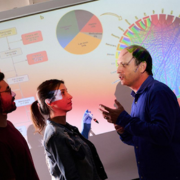TAU study: bacterial "memory" targets invading viruses
TAU researchers uncover mechanism that defends bacteria from an autoimmune attack
One of the immune system's most critical challenges is to differentiate between itself and foreign invaders — and the number of recognized autoimmune diseases, in which the body attacks itself, is on the rise. But humans are not the only organisms contending with "friendly fire."
Even single-celled bacteria attack their own DNA. What protects these bacteria, permitting them to survive the attacks?
A new study published in Nature by a team of researchers at Tel Aviv University and the Weizmann Institute of Science now reveals the precise mechanism that bacteria's defense systems use to target invading viruses, protecting their own infrastructures. According to the study, led by Prof. Udi Qimron of the Department of Clinical Microbiology and Immunology at TAU's Sackler Faculty of Medicine and Prof. Rotem Sorek of the Weizmann Institute's Molecular Genetics Department and conducted by TAU graduate student Moran Goren and Weizmann graduate student Asaf Levy, bacteria adopt two unique strategies to produce an appropriate, targeted response to foreign invaders — at minimal damage to their own DNA.
Thanks for the memories?
"Bacteria defend themselves from viral attacks thorough a defense system called 'CRISPR-Cas,'" said Prof. Qimron. "This system is adaptive, meaning it can 'memorize' a virus by sampling pieces of its DNA, and consequently launch an attack against the virus in future encounters. It was a mystery how bacteria are able to avoid attacking themselves and preferentially target viruses. But, it was only logical that the avoidance would be developed during the early 'memorization' stage of this mechanism rather than in the latter stages of attack."
A virus kills a cell by harnessing a host cell's replication machinery to make copies of itself. Years ago, Prof. Qimron pioneered studies on the memorization mechanism of CRISPR-Cas, which protects the bacterial host by inserting a short sequence of invading viral DNA straight into the bacterial genome to "remember" the infection. Bits of the viral DNA stored in special sections of the genome were found to form immune memory. In subsequent infections, the CRISPR system used these genetic sequences to create short strands of RNA that exactly fit the genetic sequence of the virus. Once protein complexes attached to the RNA identified the viral DNA, they destroyed the invading virus.
"We knew there had to be a sophisticated mechanism in place. Otherwise the bacteria, which tend to destroy its more plentiful viral invaders, would succumb to attacks, which is usually not the case," said Prof. Qimron.
Making a monkey out of DNA
Qimron's and Sorek's groups teamed up to pinpoint the precise mechanism by recording and analyzing tens of millions of memorization events against foreign DNA by the CRISPR-Cas system. The researchers injected plasmids — short, circular pieces of DNA that mimic foreign DNA — into bacteria. Two proteins, Cas1 and Cas2, were found to be responsible for acquiring pieces of plasmid DNA and avoiding bacterial DNA. In other words, the CRISPR system successfully memorized the foreign DNA for future attack, while the self-bacterial DNA was only rarely memorized.
"We can possibly use this knowledge to protect a DNA piece from attack," said Prof. Qimron. "The CRISPR-Cas system has been used in many applications, including the manipulation of DNA to generate a genetically engineered monkey. It is considered one of the most promising tools of future medicine."
The researchers are currently studying the molecular details of the memorization mechanism.
This article was originally published by AFTAU.






